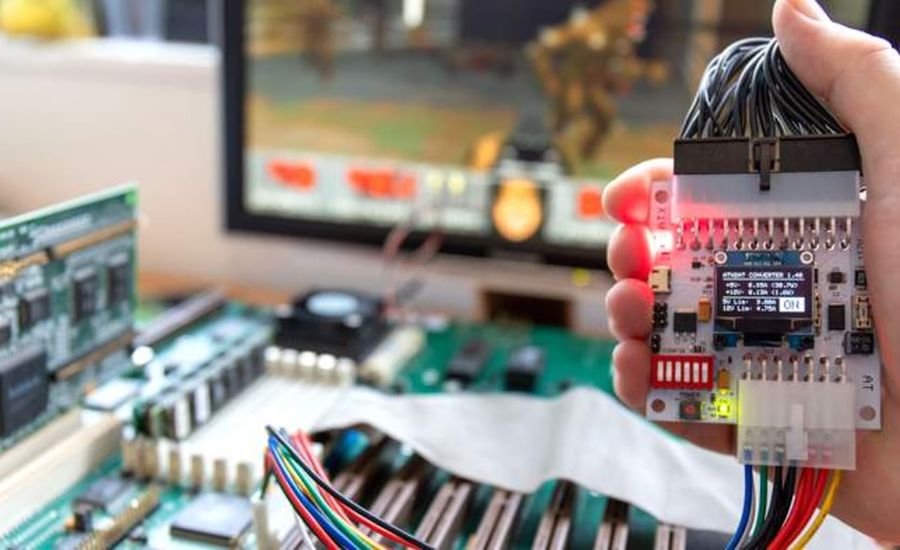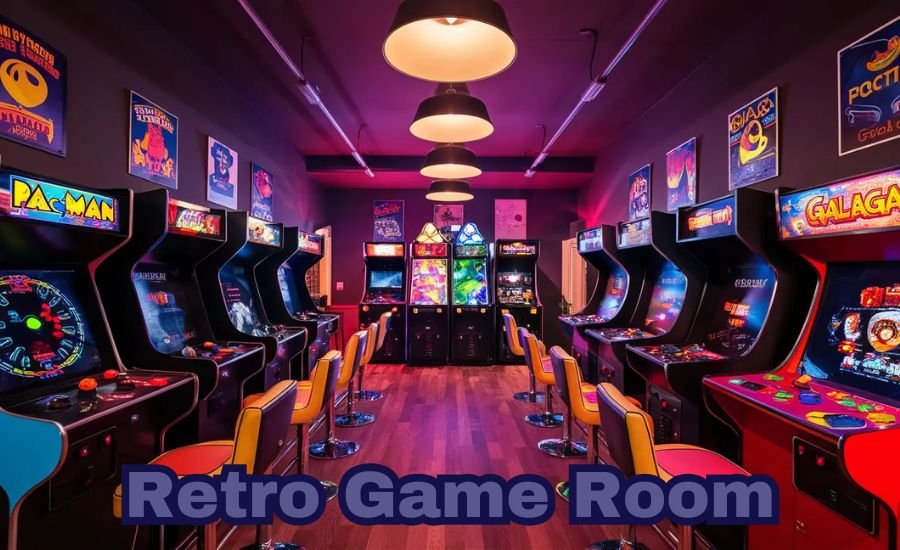Transforming your space into a retro game room is more than just a design project—it’s a nostalgic journey into the golden age of gaming. Whether you’re a long-time collector of vintage consoles or a casual gamer with a love for the classics, building a retro game room allows you to relive cherished memories and share them with others.
This guide will walk you through every step of creating a retro game room, from planning and decorating to maintaining your hardware and hosting unforgettable game nights. By the end, you’ll have the tools and inspiration to build a gaming sanctuary that combines functionality, style, and nostalgia.
What Is a Retro Game Room?
A retro game room is a dedicated space that celebrates the classic eras of video gaming, typically featuring older consoles, arcade machines, and vintage-inspired decor. It’s a place where you can revisit the games that defined your childhood or discover the charm of older titles for the first time.
Beyond just a space to play games, a retro game room can also serve as:
- A Social Hub: Invite friends and family to share in the fun.
- A Collection Display: Showcase your gaming treasures in style.
- A Relaxation Zone: Escape modern life and immerse yourself in simpler gaming experiences.
Why Create a Retro Game Room?
The appeal of a retro game room extends far beyond gaming itself. Here’s why people invest time and effort into creating these nostalgic spaces:
- Preservation of History: Retro game rooms act as museums of gaming history, preserving iconic titles, consoles, and artwork for future generations.
- Personalized Fun: Unlike modern setups, retro game rooms reflect your unique tastes and the games you cherish most.
- Connection with the Past: For many, gaming during the 80s, 90s, and early 2000s was a formative experience. A retro game room tangibly rekindles those memories.
- Aesthetic Appeal: The retro aesthetic—complete with pixel art, CRT TVs, and neon lights—offers a timeless charm that blends nostalgia with creativity.
Planning Your Retro Game Room
A well-thought-out plan is the foundation of any successful retro game room. Here are some factors to consider:
- Room Size: Determine whether you’ll dedicate an entire room or a smaller section of a space.
- Theme: Decide on a specific era or gaming brand to focus your decor and layout. For example, you could center your room around the Nintendo 64 or embrace a broader 90s aesthetic.
- Budget: Establish a realistic budget that accounts for furniture, hardware, and decor. Start small if needed, and expand your collection over time.
- Lighting and Power: Ensure the room has sufficient outlets for consoles and lighting setups.
Pro Tip: Sketch a rough layout of your ideal setup to visualize how consoles, furniture, and displays will fit into the space.
Essential Retro Consoles and Arcade Machines
To build a retro game room that truly shines, focus on collecting iconic gaming systems and machines. Some popular options include:
- Consoles: NES, SNES, Sega Genesis, Atari 2600, GameCube, and PlayStation 1. These systems offer access to many of the greatest games ever made.
- Handhelds: Don’t overlook portable systems like the Game Boy or PSP, which can also be displayed prominently.
- Arcade Machines: Classic cabinets like Pac-Man, Galaga, and Mortal Kombat bring a sense of authenticity and nostalgia to your setup.
Where to Find Them: Look for retro consoles and machines at online marketplaces, local game shops, or estate sales. Reputable resellers often refurbish systems to ensure they’re in working order.
Choosing the Right TV or Display
The display is a critical component of your retro game room, as it directly affects your gaming experience. Retro games were designed with specific hardware in mind, so choosing the right screen is essential:
- CRT TVs: These bulky, tube-based TVs are the gold standard for retro gaming. They deliver the authentic visuals that older consoles were designed for without the lag that modern TVs can introduce.
- Modern TVs with Upscalers: If space is limited or CRTs aren’t an option, use modern flat-screen TVs paired with upscalers like the OSSC or RetroTINK to enhance compatibility and picture quality.
Tip: For arcade machines, ensure their built-in displays are functional or consider professional refurbishment.
Organizing Your Console Collection
Maintaining a neat and accessible console setup can enhance your retro game room’s aesthetic and functionality. Here’s how:
- Shelving: Use sturdy, adjustable shelves to display your consoles and keep them easily accessible.
- Cable Management: Invest in cable organizers, zip ties, and cable sleeves to keep cords untangled and hidden.
- Labeling: Label power and AV cables for quick setup changes.
A clean and organized setup not only looks great but also minimizes frustration during gameplay.
Retro Game Room Furniture
Furniture plays a significant role in both the comfort and style of your retro game room. Consider these options:
- Seating: Choose ergonomic gaming chairs, bean bags, or vintage-inspired couches for a relaxed vibe.
- Tables: Coffee tables or side tables can hold controllers, snacks, and drinks. Look for designs that match your retro theme.
- Storage Solutions: Cabinets or drawers can store games, accessories, and repair tools while maintaining a clutter-free space.
Lighting and Atmosphere
Lighting can make or break the atmosphere in your retro game room. Here are some ideas to set the mood:
- LED Strips: Install LED strips behind shelves, TVs, or along walls to create customizable lighting effects.
- Neon Signs: Vintage neon signs featuring gaming icons or classic logos add a nostalgic touch.
- Accent Lights: Use colored bulbs or spotlights to highlight specific parts of your room, such as an arcade machine or game collection.
Tip: Dim lighting works best for gaming and enhances the retro vibe.
Maintaining Your Retro Hardware

Keeping your retro consoles and games in top condition ensures they’ll last for years to come. Follow these tips:
- Cleaning: Use isopropyl alcohol and cotton swabs to clean cartridge connectors and console ports.
- Storage: Store games and consoles in a cool, dry place to prevent damage from moisture or heat.
- Repairs: Learn basic repair skills or find a trusted technician to handle more complex issues.
Adding Retro Decor
The right decor will tie the whole room together and enhance the nostalgic atmosphere. Here are some ideas:
- Posters: Frame posters of your favorite games or classic gaming characters.
- Collectibles: Display action figures, Funko Pops, or other gaming merchandise to bring the room to life.
- Custom Wall Art: Incorporate pixel art, murals, or other pieces of custom artwork inspired by your favorite retro games.
The decor is an essential part of personalizing your retro game room and making it feel like a true homage to the golden age of gaming.
DIY Projects for a Personal Touch
Add a unique touch to your game room with DIY projects:
- Custom Shelves: Build shelves that are shaped like video game cartridges or controllers.
- Wall Art: Create pixel art mosaics using adhesive tiles or stickers.
- Furniture Mods: Repurpose old gaming equipment, like turning an arcade cabinet into a coffee table.
DIY projects allow you to put your personal stamp on your game room, making it truly one-of-a-kind.
Connecting Modern Tech with Retro Gear
While your focus may be on retro gear, don’t hesitate to integrate modern technology:
- Adapters: Use HDMI adapters or upscalers to connect older consoles to newer TVs.
- Streaming Equipment: Set up your game room for streaming on platforms like Twitch or YouTube. Share your retro gaming sessions with a wider audience.
Bridging the gap between retro and modern tech adds new functionality to your game room.
You May Also Like This: Comprehensive Guide to HSR Relic Scorer: Everything You Need to Know
Hosting Game Nights in Your Retro Room
Hosting a game night in your retro game room is an excellent way to share your love of classic games. Here’s how to host a successful retro gaming event:
- Multiplayer Classics: Games like Mario Kart, GoldenEye 007, and Street Fighter are perfect for group play.
- Tournaments: Organize friendly tournaments, complete with prizes, to elevate the competitive spirit.
- Era-Appropriate Snacks: Serve snacks and drinks that reflect the era of gaming you’re celebrating, such as vintage soda or arcade-inspired treats.
Hosting game nights in your retro game room will keep the nostalgia alive and create lasting memories with friends and family.
Conclusion
Creating the perfect retro game room is a fun and exciting project that lets you bring your love for old video games to life. Whether you’re a big fan of classic consoles or just want to enjoy the games that started it all, your retro game room can be a special place to relax and have fun. By planning carefully and choosing the right furniture, games, and decorations, you can turn any space into a gaming paradise that’s full of memories.
Remember, building a retro game room is all about having fun and enjoying the process. It’s a chance to celebrate the games you grew up with and share that joy with friends and family. So, start collecting your favorite consoles, add some cool decorations, and get ready to play those classic games once again!
FAQs
Q: What is a retro game room?
A: A retro game room is a dedicated space designed to celebrate classic video games, featuring vintage consoles, arcade machines, and nostalgic decor. It’s a place to play old-school games and relive memories from the past.
Q: Why should I create a retro game room?
A: Creating a retro game room allows you to preserve gaming history, connect with the past, and enjoy a personalized space filled with your favorite classic games and consoles.
Q: What kind of furniture should I use in a retro game room?
A: Choose comfortable seating like ergonomic chairs or vintage-inspired couches, along with tables for controllers and snacks. Storage options like cabinets or shelves will help keep games and consoles organized.
Q: Do I need a CRT TV for a retro game room?
A: While a CRT TV provides the most authentic retro gaming experience, modern TVs with upscale can also work well if space is limited or you don’t have a CRT available.
Q: Where can I find retro games and consoles?
A: You can find retro games and consoles on online marketplaces like eBay, local thrift stores, and retro gaming shops. Estate sales and conventions are also good places to search.
Q: How do I keep my retro consoles in good condition?
A: Clean your consoles regularly with isopropyl alcohol and cotton swabs, store them in a dry, cool place, and handle them gently to avoid damage. Regular maintenance ensures they last longer.
Q: Can I connect modern tech to my retro game room setup?
A: Yes! You can use adapters and upscalers to connect older consoles to modern TVs. You can also incorporate streaming equipment to share your gaming sessions on platforms like Twitch or YouTube.
Explore More On: Techipes



